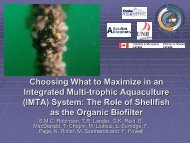Integrated multi-trophic aquaculture (IMTA) in marine temperate waters
Integrated multi-trophic aquaculture (IMTA) in marine temperate waters
Integrated multi-trophic aquaculture (IMTA) in marine temperate waters
Create successful ePaper yourself
Turn your PDF publications into a flip-book with our unique Google optimized e-Paper software.
<strong>Integrated</strong> <strong>multi</strong>-<strong>trophic</strong> <strong>aquaculture</strong> (<strong>IMTA</strong>) <strong>in</strong> mar<strong>in</strong>e <strong>temperate</strong> <strong>waters</strong> 27<br />
The general benefit from <strong>IMTA</strong>, i.e. reduction of nutrient release to the environment,<br />
is also true for <strong>in</strong>tegrated seaweed-abalone culture. Furthermore, as seaweeds remove<br />
ammonium from the seawater and add oxygen, the abalone wastewater pass<strong>in</strong>g<br />
through seaweed ponds can be partially re-circulated back to the abalone tanks, thus<br />
potentially reduc<strong>in</strong>g pump<strong>in</strong>g costs. The ability to operate <strong>in</strong> re-circulation mode is<br />
important as red tides occasionally occur along the South African coast. Moreover,<br />
some coastal areas experience heavy traffic of tanker boats, which represent potential<br />
risks for oil spills. It has been shown that a farm can operate successfully at 50 percent<br />
re-circulation, and even higher recirculation (up to 100 percent) can be susta<strong>in</strong>ed<br />
for shorter periods. This can, of course, be optimized, depend<strong>in</strong>g on what the ma<strong>in</strong><br />
objective is with re-circulation. The re-circulation through seaweed tanks/ponds also<br />
has the potential to raise water temperature, which can stimulate abalone growth<br />
<strong>in</strong> areas of cold coastal <strong>waters</strong>. Compared to many other <strong>aquaculture</strong> operations,<br />
there is currently no real environmental pressure from abalone wastewater release <strong>in</strong><br />
South Africa. Wastes from abalone operations are different from those of fish, with<br />
significantly lower concentrations of both nitrogen and phosphorus. This implies that<br />
the seawater <strong>in</strong> the seaweed tanks needs to be fertilized to susta<strong>in</strong> seaweed growth.<br />
This additional <strong>in</strong>put of nutrients would not be needed if seawater from fish tanks<br />
were to be used (this has been tested with success). The development of <strong>IMTA</strong> <strong>in</strong> South<br />
Africa has, <strong>in</strong> fact, been driven by other <strong>in</strong>centives, such as future limitation of wild<br />
kelp harvest<strong>in</strong>g and the proven economic benefits from improved abalone growth and<br />
quality with seaweed diets.<br />
There is also strong socio-economic pressure on the South African government<br />
to create more jobs <strong>in</strong> the area, which has high unemployment and poverty levels<br />
(Troell et al., 2006). The further expansion and permanent job creation potential of<br />
this <strong>in</strong>dustry, as well as <strong>in</strong>direct related jobs, <strong>in</strong> remote coastal communities, is very<br />
attractive. Thus there is much support for this practice of co-cultivat<strong>in</strong>g kelp with<br />
abalone, from government, <strong>in</strong>dustry and the general population.<br />
There may also be <strong>in</strong>centives to move <strong>IMTA</strong> concepts <strong>in</strong>to the mussel grow<strong>in</strong>g<br />
<strong>in</strong>dustry <strong>in</strong> Saldahna Bay. Studies have shown that the large mussel culture rafts are<br />
impact<strong>in</strong>g the benthos <strong>in</strong> the Bay, suggest<strong>in</strong>g that stock<strong>in</strong>g densities are too high for<br />
natural assimilation of the organic load to the bottom (Stenton-Dozey, Probyn and<br />
Busby, 2001).<br />
Asia<br />
Ch<strong>in</strong>a<br />
The level of <strong>IMTA</strong> development <strong>in</strong> the mar<strong>in</strong>e <strong>temperate</strong> <strong>waters</strong> of Ch<strong>in</strong>a is not easy<br />
to apprehend, as published <strong>in</strong>formation on <strong>IMTA</strong> <strong>in</strong> that country is difficult to f<strong>in</strong>d or<br />
access. Describ<strong>in</strong>g the development of <strong>IMTA</strong> <strong>in</strong> Ch<strong>in</strong>a is really beyond the scope of<br />
this review; it would, however, deserve a review on its own, written by Ch<strong>in</strong>ese authors<br />
or by people with a rare and prolonged <strong>in</strong>sight <strong>in</strong> the history of <strong>aquaculture</strong> <strong>in</strong> that<br />
vast country.<br />
<strong>IMTA</strong> <strong>in</strong> Ch<strong>in</strong>a will be covered succ<strong>in</strong>ctly below by report<strong>in</strong>g on two examples of<br />
variations on this practice approach: suspended <strong>multi</strong>-species <strong>aquaculture</strong>, generally <strong>in</strong><br />
shallow nearshore <strong>waters</strong>, and <strong>multi</strong>-species large scale sea ranch<strong>in</strong>g <strong>in</strong> more offshore<br />
and deeper <strong>waters</strong> (J. Fang, pers. comm.). The reader should note the large scale of<br />
these enterprises.<br />
An example of suspended <strong>multi</strong>-species <strong>aquaculture</strong> is what is be<strong>in</strong>g developed <strong>in</strong><br />
Sungo Bay, <strong>in</strong> the East of the Shandong Pen<strong>in</strong>sula. Scallops (Chlamys farreri, 2 100<br />
tonnes fresh weight <strong>in</strong> 2005) and oysters (Crassostrea gigas, 110 000 tonnes fresh<br />
weight) are cultivated, on the same long l<strong>in</strong>e system, with the kelp, Lam<strong>in</strong>aria japonica<br />
(80 000 tonnes fresh weight). The cultivation zone extends to 8 km offshore with a<br />
water depth of around 20-30 m. The co-cultivation of abalone (Haliotis discus hannai,



